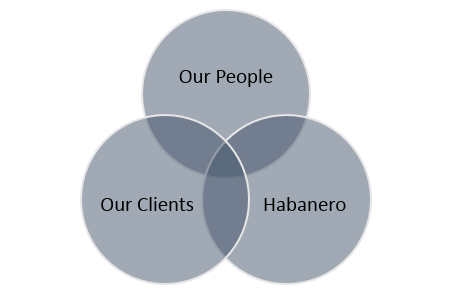In fact, not a lot of companies give much thought to their structure at all. You have a boss, your boss has a boss, and at the top is the CEO (or president, or general manager, etc.). My last job, and all of the ones before it, were structured this way, which is why Habanero took some getting used to.
At Habanero, information flows freely and the adversarial mindset that often results from strict hierarchies does not exist. But pyramid-shaped management structures exist for a reason; they ensure that responsibilities are clear, employees are accountable to someone, and career paths are obvious.
How, then, does a flat organization like ours cope? Through peer mentorship and support. The theory is this: Employees who feel valued (and valuable) and who are able to cultivate authentic work relationships are the ones we want to have around, and every employee has a performance manager to help them get there.
Having been at Habanero for quite some time now, it’s become clear to me that the key to the lattice structure is the performance manager and the direct support they provide to every employee here.
In some ways, performance managers fill the role of a traditional boss in that they are responsible for stewarding Habanero employees throughout their career. They’re able to help navigate, partly because they’ve been through the same process themselves, but mainly because performance managers have a genuine interest in your career and continued success. This is why not every employee is a performance manager, because not everyone is passionate about coaching employees throughout their time at Habanero.
The ideal performance manager
Performance managers, like any mentor, need to understand why certain behaviors are being exhibited (good ones and bad). They need to know what motivates what discourages, and they need to take genuine interest in their peoples’ lives.
With this, PMs can identify where an employee will shine, why they might be struggling, or how to get them truly energized. Not everyone can do this sort of thing; it’s as much psychology as it is business, and it takes a unique perspective to make it work.
More than anything, the mentor and mentee need to be compatible. The mentee will often look to their mentor to help define them in the context of their work and to get their specific strengths working in a way that is productive for them, for Habanero, and for our clients. We aim squarely for the middle:

It’s obvious, but worth reiterating: spend less time fitting people into roles and more time exploring which roles are the right ones.
The benefits of performance management
The benefits of this approach are well-understood: employees ramp up faster, stay longer, are more productive, and make greater contributions to their company and its culture. But these are all about the bottom line. Why does Habanero do it? Because employee learning and growth is not a means to an end – it is the end. Set out to be a well-run organization, and the great workplace can’t help but follow1.
- I grabbed this quote from Cat Sanders’ post on being a great company, which is definitely worth reading if you’re interested in this kind of content.





